|
|
| |
|
|
| |
|
| History of the M61 Class | |
|
|
| |
|
|
| |
|
|
MÁV's need for a mainline diesel In Hungary, steam traction approached its decline by the end of the 1950's, and like many railroads throughout the world, MÁV set up plans for purchasing diesel and electric motive power. At that time, only a few lines were electrified and therefore the demand for a mainline diesel locomotive was of especially high importance. The domestic industry was successful in developing diesel switchers (M28 with 100/147 kW, M44 with 440 kW, later also a famous export locomotive), but the attempts at mainline diesel motive power in the 1500 kW range failed at length. There were already plans for an envisaged mainline diesel in the 1940's, a single-cab "shovel-nose" construction reminiscent of the famous Hungarian "Hargita" trainsets and derivatives used in South America, but partly because of the world war, these plans never materialized. After the war, Ganz built an experimental locomotive rated at 1472 kW (Ganz DVM-3 which would have become the class M601 at MÁV), but it remained an unsuccessful project, cancelled in 1957 after a serious prime mover damage. The demonstrators In 1960, after MÁV had placed a tender for a mainline diesel locomotive, two demonstrators were tested in Hungary. One was a six-axle diesel-hydraulic with 1546 kW nominal output, built by Krauss-Maffei (its four-axle version was already in service at DB as class V200). The road number M61-2001 was temporarily assigned to the locomotive during test runs on MÁV's lines which lasted altogether about two weeks. 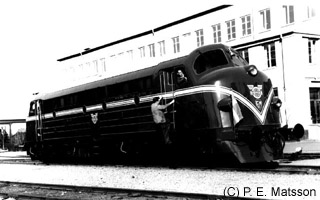 Nydqvist & Holm AB of Sweden also sent a demonstrator at MÁV's
request. This locomotive, derived from EMD's F-units was internally almost
equivalent to EMD's FP7, being powered by an EMD 16-567-C prime mover
and using DC electric transmission. The particular unit
sent to Hungary was a "leftover" from a batch expected to
be taken by Finland, who, however did not choose the NOHAB locomotives.
After demonstrator service in Eastern Europe, the unit joined Norway's
Di3 fleet just as the rest of the batch, and became Di3.623.
Nydqvist & Holm AB of Sweden also sent a demonstrator at MÁV's
request. This locomotive, derived from EMD's F-units was internally almost
equivalent to EMD's FP7, being powered by an EMD 16-567-C prime mover
and using DC electric transmission. The particular unit
sent to Hungary was a "leftover" from a batch expected to
be taken by Finland, who, however did not choose the NOHAB locomotives.
After demonstrator service in Eastern Europe, the unit joined Norway's
Di3 fleet just as the rest of the batch, and became Di3.623.Placing the order After the test runs had been conducted, MÁV was satisfied with the performance of both demonstrators, but finally NOHAB's construction was favored. One of the main reasons for this decision was the use of two prime movers in the Krauss-Maffei locomotive, as opposed to NOHAB's construction using only one low-RPM 16-cylinder engine, EMD's 567 which was already known for its durability and reliability, well-proven in thousands of locomotives, ships and stationary power equipment. The electric transmission of NOHAB's demonstrator also supported the decision, since hydraulic transmission, especially the hydrodynamic kind, was still in its infancy with nothing known about its long-term availability, and recent, not quite positive experience with the M31 hydraulics (which, however, improved much in reliability later) showed the risks of such unexplored terrain. That the Krauss-Maffei locomotive should not be discarded right away can, however, be still demonstrated by the fact that its four-axle version had a respectable service record at DB, OSE and JZ, and some units even survived at second-hand owners, such as Italian private railroads.  MÁV's decision resulted
in an order of 20 units from NOHAB, delivered in 1963 and 1964.
Later on, NOHAB also offered a locomotive with a turbocharged 645 engine
(known as MZ in Denmark),
but because of financial, political and personal interests, no further
units could be purchased from NOHAB. Instead, the M62,
developed in the Soviet Union especially for standard gauge service,
was chosen for further dieselization. Hungary was to receive the first
units of the series, so MÁV struggled with the teething troubles
of an immature construction, from unacceptable noise emission to the
– still existing – poor fuel efficiency while the M61's gave excellent service
from the beginning on.
MÁV's decision resulted
in an order of 20 units from NOHAB, delivered in 1963 and 1964.
Later on, NOHAB also offered a locomotive with a turbocharged 645 engine
(known as MZ in Denmark),
but because of financial, political and personal interests, no further
units could be purchased from NOHAB. Instead, the M62,
developed in the Soviet Union especially for standard gauge service,
was chosen for further dieselization. Hungary was to receive the first
units of the series, so MÁV struggled with the teething troubles
of an immature construction, from unacceptable noise emission to the
– still existing – poor fuel efficiency while the M61's gave excellent service
from the beginning on.
The years of service 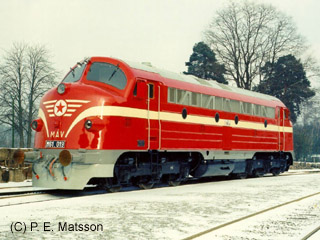 The first two locomotives of the class (M61-001 and 002) entered regular service
in May 1963, and the delivery of the remaining units also took place in
1963 and early 1964. In the first years of service, the M61's were, beyond doubt, real
flagships of MÁV's diesel fleet, no wonder that they belonged to
one of the most eminent depots – to "Hámán
Kató" depot (now "Budapest-North").
The first ten units were thus assigned to Budapest, while the others to
Debrecen. With the better part of the class still to be delivered, the
first units performed
on the Budapest – Miskolc line for some months to eliminate
the motive power shortage of that line, but later, all machines were used
on the Budapest – Vienna, Budapest – Cegléd – Szolnok – Debrecen – Nyíregyháza – Záhony,
Budapest – Párkány (túrovo), Budapest – Újszász – Szolnok – Békéscsaba – Kürtös (Curtici)
and Budapest – Kelebia – Szabadka (Subotica) lines in fast passenger and fast transit
freight service.
The first two locomotives of the class (M61-001 and 002) entered regular service
in May 1963, and the delivery of the remaining units also took place in
1963 and early 1964. In the first years of service, the M61's were, beyond doubt, real
flagships of MÁV's diesel fleet, no wonder that they belonged to
one of the most eminent depots – to "Hámán
Kató" depot (now "Budapest-North").
The first ten units were thus assigned to Budapest, while the others to
Debrecen. With the better part of the class still to be delivered, the
first units performed
on the Budapest – Miskolc line for some months to eliminate
the motive power shortage of that line, but later, all machines were used
on the Budapest – Vienna, Budapest – Cegléd – Szolnok – Debrecen – Nyíregyháza – Záhony,
Budapest – Párkány (túrovo), Budapest – Újszász – Szolnok – Békéscsaba – Kürtös (Curtici)
and Budapest – Kelebia – Szabadka (Subotica) lines in fast passenger and fast transit
freight service.Later, the area of their traction service was extended to all non-electrified mainlines, e. g. Budapest – Szeged, Budapest – Biharkeresztes, Budapest – Keszthely, Budapest – Nagykanizsa, Budapest – Tapolca – Zalaegerszeg, Budapest – Gyékényes, Budapest – Pécs and Budapest – Hatvan – Somoskõújfalu. For a short period of time, M61's also appeared on the Budapest – Szombathely line in 1968. After the delivery of M62's had begun, M61's were almost exclusively used in passenger service, since, unlike M62's, the NOHAB locomotives were equipped with a steam generator. (At that time, no Soviet locomotive had train-heating equipment, since at SZD, every passenger car had its own coal-heated stove for that purpose. But because M62's also had to perform in passenger service, head-end-power cars were later supplied by Ganz-MÁVAG, this arrangement making M62-powered trains avid fuel-eaters.) During the years of service, the M61's earned high esteem with the engineers and maintenance personnel as well. No other diesel locomotive could be a match for them in reliability and technical perfection. Their durability showed especially in the last decades of their service when, despite of insufficient maintenance, M61's still gave better service than other classes which were better fed with repairs and finances. In the first times of service, engineers allowed no one to enter the engine room without supervision and took care of the machines with painstaking thoroughness. Being assigned to an M61 meant the highest reputation, something most engineers could not even dream of. The traveling public also learned to love the locomotives, be it for their sound, much more inspiring than the dissonant whistling or empty rumbling of some other domestic diesel power, or their majestic appearance, so charming among the other boxy things. In other words, the M61 class became a legend in Hungary, as it happened to their sisters in Norway and Denmark, or their ancestors in Australia or America. From the 1970's on, MÁV invested much in mainline electrification, the process being accelerated also by rising fuel prices. As a result, M61's disappeared gradually from all Eastern mainlines. Being confined mostly to the Western part of MÁV's network, the locomotives were reassigned to Tapolca in the years 1979–1983 and 1988–1990. The last units being moved to Tapolca were the former government locomotives 014 and 019. Simultaneously, the traction area of M61's shrunk to the Budapest – Tapolca – Celldömölk and Budapest – Nagykanizsa lines. In the end, their service was constrained to the northern shore of Lake Balaton between Székesfehérvár and Tapolca/Celldömölk (lines 29 and 26), and to lines 20, 26, 26a (now 30b) and 36 from Szombathely over Celldömölk, Tapolca, to Balatonszentgyörgy, Fonyód and Kaposvár. It was in these last two decades that the shores of the Balaton became individible from M61's. Their sound and their sight fit so naturally into the atmosphere of the lake and the surrounding mountains as if these locomotives were created especially for this place. Now that their service is over, it is for many people – including thousands of tourists – disillusioning to see a smoke-belching M62 struggle with a delayed train or to hear the rattling of an M41 (a Ganz-MÁVAG-built diesel-hydraulic) disgrace the peace of the mountains. Retirement Electrification, old age and occasional accidents may have been the natural enemies of the M61's, but obviously, there were other less visible interests that led to the machines' demise. Compared to more than 40 service years of DSB's MY class and NSB's Di3 class, the M61's were to meet a premature end as MÁV's leadership decided on the elimination of the series in the late 1980's. A variety of reasons were given, both political and economical, to justify the decrease in repairs, withdrawal of finances for acquiring spare parts and scrapping of units, some in operable condition. The first unit to be withdrawn was M61-009, scrapped due to a minor accident in 1987 after which its underframe was declareded damaged. Other units quickly followed, some of them still serviceable or suffering of minor, or at least reparable failures. M61-003 was, for example, officially scrapped because of wheel flange wear. Even if it was clear that no suitable replacement could be found in MÁV's diesel fleet, the senseless holocaust was also continued after the end of the socialist era in 1989, still in the same short-sighted manner as before; because of the same interests, one could guess.  Yet, even the last years brought some highlights and significant events.
To commemorate the 125th anniversary of MÁV, M61-004 was repainted
into a red and white livery in 1993, in an attempt to restore the original paint
scheme changed in the mid-seventies to the current dark orange. In the
summer of that year, a meeting of GM-powered locomotives took place at
Tapolca, where beyond M61-004 and a still bright and clean M61-002,
also an Austrian 2050 (Henschel J12), a Croatian 2063 (EMD GT26CW) and
a 2061 (EMD G16) were on
display, among other non-GM motive power, including steam locomotives.
The nicely restored buildings
of the station and the promises made by the railroad's leadership suggested
that at least some better years were to come, but this turned out to be an
illusion; the rest of the M61 story being rather like what the ominous
torso of M61-018, still in Tapolca during the above event, may have foreshadowed.
Yet, even the last years brought some highlights and significant events.
To commemorate the 125th anniversary of MÁV, M61-004 was repainted
into a red and white livery in 1993, in an attempt to restore the original paint
scheme changed in the mid-seventies to the current dark orange. In the
summer of that year, a meeting of GM-powered locomotives took place at
Tapolca, where beyond M61-004 and a still bright and clean M61-002,
also an Austrian 2050 (Henschel J12), a Croatian 2063 (EMD GT26CW) and
a 2061 (EMD G16) were on
display, among other non-GM motive power, including steam locomotives.
The nicely restored buildings
of the station and the promises made by the railroad's leadership suggested
that at least some better years were to come, but this turned out to be an
illusion; the rest of the M61 story being rather like what the ominous
torso of M61-018, still in Tapolca during the above event, may have foreshadowed.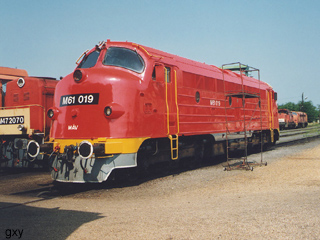 Other noteworthy events were the renewal of M61-006 in 1995 which
included, among others, repainting and major prime mover repair, and in 1996 –
not less spectacular – the resurrection of M61-019 who was on the verge of scrapping for quite a while.
But 1996 also brought a less pleasant change.
With the introduction of the new timetable in June, the service area
of M61's was further decreased. Now the trains between Tapolca and Budapest
were taken over by an electric locomotive at Székesfehérvár
and an M61 became a rare sight in Budapest.
That year also brought the end of steam heating, so a number of M61's were
equipped with controls for a HEP car (generator car), even if on some occasions the
steam generators were still used.
As the M61 roster thinned out and also M41's and M62's had to be used in addition to the remaining units,
delays and broken-down locomotives became a quite common occurrence;
an obvious degradation even for a "plain" passenger. What is not
known to laymen, however, is that the M61's gave their more reliable service
despite of systematic neglect (no oil change was performed in the
prime mover of any M61 in the last decade) and spare parts salvaged from
cannibalized units.
Other noteworthy events were the renewal of M61-006 in 1995 which
included, among others, repainting and major prime mover repair, and in 1996 –
not less spectacular – the resurrection of M61-019 who was on the verge of scrapping for quite a while.
But 1996 also brought a less pleasant change.
With the introduction of the new timetable in June, the service area
of M61's was further decreased. Now the trains between Tapolca and Budapest
were taken over by an electric locomotive at Székesfehérvár
and an M61 became a rare sight in Budapest.
That year also brought the end of steam heating, so a number of M61's were
equipped with controls for a HEP car (generator car), even if on some occasions the
steam generators were still used.
As the M61 roster thinned out and also M41's and M62's had to be used in addition to the remaining units,
delays and broken-down locomotives became a quite common occurrence;
an obvious degradation even for a "plain" passenger. What is not
known to laymen, however, is that the M61's gave their more reliable service
despite of systematic neglect (no oil change was performed in the
prime mover of any M61 in the last decade) and spare parts salvaged from
cannibalized units.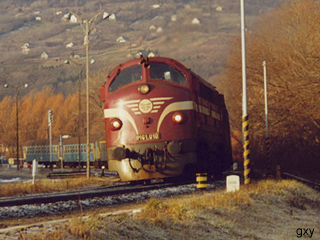 In the last years of service, also private initiatives were undertaken
to help the survival of the locomotives. The most spectacular result was, in 1997,
the repainting of M61-010 to the old maroon and white livery, but
also the engineer's cab of the unit was partly renewed – all with private
finances, without receiving official or unofficial thanks from the railroad.
Also noteworthy, M61-004 was placed under protection of the Museum of
Transport and a contract was about to be signed between the Town of Tapolca and MÁV
about the locomotive's permanent assignment to the town which has been the
home base of the class for nearly two decades. The locomotive was given the
name "Tapolca" in 1997, being thus the only diesel locomotive
bearing a name (in Hungary, only some electrics are named after famous people and cities).
Two years later, however, the locomotive was irreparably damaged in a
derailment, caused by an over-aged tree on the tracks in a storm and hit
by the locomotive at 80 km/h. Shortly
thereafter, many trees along the railway line were hastily cut down, but
this could, of course, not bring the locomotive back to life, nor give hope
that some railroad officials will remember the planned contract with Tapolca.
The replacement for a museum locomotive was quickly found; M61-020
was repainted to the old livery within a few months after the accident. The
prime mover of 004 remained intact and could have survived in another
locomotive, had it not been cut up without too many thoughts. Later that year,
one engineer's cab of the locomotive was cut down to become a museum exhibit
after restoration.
In the last years of service, also private initiatives were undertaken
to help the survival of the locomotives. The most spectacular result was, in 1997,
the repainting of M61-010 to the old maroon and white livery, but
also the engineer's cab of the unit was partly renewed – all with private
finances, without receiving official or unofficial thanks from the railroad.
Also noteworthy, M61-004 was placed under protection of the Museum of
Transport and a contract was about to be signed between the Town of Tapolca and MÁV
about the locomotive's permanent assignment to the town which has been the
home base of the class for nearly two decades. The locomotive was given the
name "Tapolca" in 1997, being thus the only diesel locomotive
bearing a name (in Hungary, only some electrics are named after famous people and cities).
Two years later, however, the locomotive was irreparably damaged in a
derailment, caused by an over-aged tree on the tracks in a storm and hit
by the locomotive at 80 km/h. Shortly
thereafter, many trees along the railway line were hastily cut down, but
this could, of course, not bring the locomotive back to life, nor give hope
that some railroad officials will remember the planned contract with Tapolca.
The replacement for a museum locomotive was quickly found; M61-020
was repainted to the old livery within a few months after the accident. The
prime mover of 004 remained intact and could have survived in another
locomotive, had it not been cut up without too many thoughts. Later that year,
one engineer's cab of the locomotive was cut down to become a museum exhibit
after restoration.
And finally, the last year of service came. M61-001 was taken over by MÁV Nosztalgia Ltd. in March 2000. Because it was already lacking two traction motors since late 1999, M61-019, still in flawless condition, was robbed of its trucks, despite the fact that there were some renewable traction motors in the "Északi" repair shops in Budapest. M61-001 was then repainted to the old red and white livery as well and made its debut somewhat later – how unusual for an EMD – with prime mover problems. In the summer of that year, out-of-service M61-002 was therefore stealthily taken to Budapest to donate prime mover parts and other innards to 001; nota bene, only a few months after cutting up 004's engine! Thus, only three units survived the first plundering campaign in Tapolca; 006, 010 and 020. They were in service through that last summer and two were gradually taken out of regular use in late fall 2000. M61-020 kept working on occasional assignments until the unexpected complete withdrawal of the class was announced late December 2000, just in time to spoil Christmas for thousands who adored and loved these locomotives. 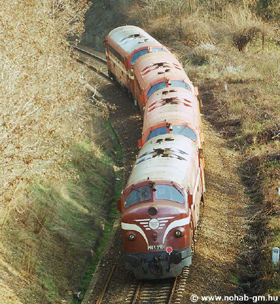 The last scheduled train operated by an M61 for MÁV ran on 21 December 2000, when M61-020 operated train 974 between Székesfehérvár and Tapolca, where an M41 took over for the rest of the trip to Celldömölk. At least their service ended in a classical way, hauling a fast train as their career of nearly four decades began. The next morning, the four locos remaining at Tapolca (M61-019 having been out of use for 10 months, M61-006 and 010 not being used for some days or weeks, and only M61-020 in operational condition) were moved to Budapest. M61-020 hauled the other three sisters and ran at speeds up to 100 km/h. After the personnel from Tapolca had been virtually driven out of the engineer's cab, the machines were taken to MÁV Nosztalgia Ltd; for "temporary storage," as it was said.
The last scheduled train operated by an M61 for MÁV ran on 21 December 2000, when M61-020 operated train 974 between Székesfehérvár and Tapolca, where an M41 took over for the rest of the trip to Celldömölk. At least their service ended in a classical way, hauling a fast train as their career of nearly four decades began. The next morning, the four locos remaining at Tapolca (M61-019 having been out of use for 10 months, M61-006 and 010 not being used for some days or weeks, and only M61-020 in operational condition) were moved to Budapest. M61-020 hauled the other three sisters and ran at speeds up to 100 km/h. After the personnel from Tapolca had been virtually driven out of the engineer's cab, the machines were taken to MÁV Nosztalgia Ltd; for "temporary storage," as it was said.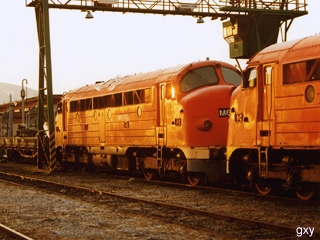 Though the history of the Hungarian NOHAB's is far from finished, little is expected to change in the next few years. 001 (externally restored and kept operable) and 020 are to remain in MÁV's ownership, yet are operated by the Nosztalgia Ltd. as revenue earning museum locomotives while 019 and 006, both in more or less operating condition, were purchased by the Nosztalgia Ltd. in mid-2001.
The life of M61-017 (now renumbered to 2761 017-9) was saved a while ago with the help of Tapolca depot; its premature retirement was avoided by its temporary restoration to operating condition. Since 017 was away hauling a train on the day scheduled for its retirement, it could stay in service to be taken over somewhat later by the MoW department. Now, after an overhaul, 017 will live on as a designated locomotive for track measuring trains. M61-010 became our foundation's own machine – looking forward to serving the railway enthusiasts who saved it so many times from the cutting torch. M61-002 has been thoroughly gutted during its captivity in Budapest, and apparently, much effort has been made to erase all hopes of 002 becoming a serviceable locomotive again. The remnants were planned to be cut up in early 2005, however, our foundation purchased the empty carbody and thus managed to save it form the cutting torch. Though a resurrection of 002 is not impossible, the huge amount of work and finances necessary for a complete restoration is certain to put these plans off for at least a decade.
Though the history of the Hungarian NOHAB's is far from finished, little is expected to change in the next few years. 001 (externally restored and kept operable) and 020 are to remain in MÁV's ownership, yet are operated by the Nosztalgia Ltd. as revenue earning museum locomotives while 019 and 006, both in more or less operating condition, were purchased by the Nosztalgia Ltd. in mid-2001.
The life of M61-017 (now renumbered to 2761 017-9) was saved a while ago with the help of Tapolca depot; its premature retirement was avoided by its temporary restoration to operating condition. Since 017 was away hauling a train on the day scheduled for its retirement, it could stay in service to be taken over somewhat later by the MoW department. Now, after an overhaul, 017 will live on as a designated locomotive for track measuring trains. M61-010 became our foundation's own machine – looking forward to serving the railway enthusiasts who saved it so many times from the cutting torch. M61-002 has been thoroughly gutted during its captivity in Budapest, and apparently, much effort has been made to erase all hopes of 002 becoming a serviceable locomotive again. The remnants were planned to be cut up in early 2005, however, our foundation purchased the empty carbody and thus managed to save it form the cutting torch. Though a resurrection of 002 is not impossible, the huge amount of work and finances necessary for a complete restoration is certain to put these plans off for at least a decade.
What the next years have in store for the Hungarian NOHAB's remains unknown for now. Yet, whatever the future may bring, we shall never forget what one of the engineers in Tapolca said after ending nearly twenty years of service on an M61: "They may have taken our locomotives, but they can never take the two decades the machines gave me." |
|